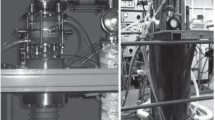Abstract
We develop a multi-mode time-domain model for theoretical description of mode competition in a planar gyrotron with sheet beam of rotating electrons and transverse energy extraction. Within the frame of this model, we demonstrate an improvement of mode selectivity and power increasing in the case of excitation of high-order cyclotron harmonics in terahertz-range planar gyrotrons. The obtained results are confirmed based on direct 3D PIC (particle-in-cell) simulations.





Similar content being viewed by others
References
J. H. Booske, R. J. Dobbs, C. D. Joye, C. L. Kory, G. R. Neil, G.-S. Park, J. Park, and R. J. Temkin. IEEE Trans. THz Sci. Techn. 1, 1, 54–75 (2011)
M.Yu.Glyavin, T.Idehara, and S.P.Sabchevski. IEEE Trans. THz Sci. Techn, 5, 788 (2015)
M. Yu. Glyavin, A. G. Luchinin, and G. Yu. Golubiatnikov. Phys. Rev. Lett., 100, 015101 (2008).
M.Yu. Glyavin, A. G. Luchinin, G. S. Nusinovich, J. Rodgers, D. G. Kashyn, C. A. Romero-Talamas, R. Pu., Appl. Phys. Lett., 101, 153503, 2012
M. K. Hornstein, V. S. Bajaj, R. G. Griffin, K. E. Kreischer, I. Mastovsky, M. A. Shapiro, J. R. Sirigiri, and R. J. Temkin. IEEE Trans. Electron Devices, 52, 798 (2005).
T. Idehara, I. Ogawa, S. Mitsudo, Y. Iwata, S. Watanabe, Y. Itakura, K. Ohashi, H. Kobayashi, T. Yokoyama, V. E. Zapevalov, M. Yu. Glyavin, A. N. Kuftin, O. V. Malygin, S. P. Sabchevski, IEEE T. Plasma Sci., 32, 3, 903–909 (2004)
V. L. Bratman, Yu. K. Kalynov, and V. N. Manuilov, Phys. Rev. Lett., 102, 245101 (2009).
Yu. K. Kalynov, V. N. Manuilov, A. Sh. Fiks, N. A. Zavolskiy, Appl. Phys. Lett.114, 213502 (2019)
T. Idehara, M. Glyavin, A. Kuleshov, S. Sabchevski, V. Manuilov, V. Zaslavsky, I. Zotova, and A. Sedov, Rev. of Sci. Instr. 88, 094708 (2017).
T. Idehara, K. Kosuga, L. Agusu, I. Ogawa, H. Takahashi, M. E. Smith, R. Dupree, J. Infrared Millim. Terahertz Waves, 31, 763–774 (2010)
M. Thumm, K. A. Avramidis, J. Franck, G. Gantenbein, S. Illy, J. Jin, P. C. Kalaria, I. Gr. Pagonakis, S. Ruess, C. Wu and J. Jelonnek, IEEE Trans. THz Sci. Techn 11, 1, 1–20 (2018)
R. Hirose, S. Hayashi, S. Fukumizu, Y. Muroo, H. Miyata, Y. Okui, A. Itoki, T. Kamikado, O. Ozaki, Y. Nunoya, and K. Okuno, IEEE Trans. Appl. Superconductivity, 16, 953 (2006).
N. S. Ginzburg, I. V. Zotova, A. S. Sergeev, V. Yu. Zaslavsky, and I. V. Zheleznov, Phys. Rev. Lett., 108, 105101 (2012).
A. V. Gaponov, V. A. Flyagin, A. L. Goldenberg, G. S. Nusinovich, S. E. Tsimring, V. G. Usov, S. N. Vlasov, Int. Journal of Electronics, 51, 277, (1981).
N. S. Ginzburg, M. Yu. Glyavin, A. M. Malkin, V. N. Manuilov, R. M. Rozental, A. S. Sedov, A. S. Sergeev, V. Yu. Zaslavsky, I. V. Zotova, and T. Idehara, IEEE Trans. Plasma Sci., 40 (8), 1303 (2016).
V. N. Manuilov, V. Yu. Zaslavsky, N. S. Ginzburg, M. Yu. Glyavin, A. N. Kuftin, and I. V. Zotova, Phys. Plasmas, 21, 023106 (2014).
X. Yuan, Y. Lan, C. Ma, Y. Han, and Y. Yan, Phys. Plasmas, 18, 103115 (2011)
Author information
Authors and Affiliations
Corresponding author
Additional information
Publisher’s Note
Springer Nature remains neutral with regard to jurisdictional claims in published maps and institutional affiliations.
Appendix
Appendix
Here, we derive the equations for field evolution taking into account the partial penetration of radiation through the collector narrowing. For simplicity, we will further neglect the Ohmic losses as well as the inhomogeneity of the field along the “open” coordinate X in the equation for TEn mode amplitudes (cf. Eq. 5a):
where the function
describes the longitudinal profile of the resonator (see Fig. 1b), ωn(Z) is the TEn mode cutoff frequency in cross section Z.
The boundary condition an(Z = 0) = 0 allows us to present the longitudinal structure of the field as:
where Ω is the complex frequency, and
are the longitudinal wavenumbers inside (zone I in Fig. 1b) and outside (zone II) of the interaction space, respectively. If the planar cavity is weakly perturbed,
Using the continuity of the transverse electric and magnetic fields in the cross section Z = Lz, we obtain the characteristic equation which determines eigenfrequencies Ω
Thus, as the first approximation of the perturbation theory, we obtain for \( {\tilde{\chi}}_{nm} \):
When \( {\overline{\delta}}_n>{\left( m\pi /{L}_z\right)}^2,\kern0.66em {D}_{nm}={\left( m\pi /{L}_z\right)}^2-{\overline{\delta}}_n<0 \), the value of \( {\tilde{\chi}}_{nm} \) is real and the corresponding resonator mode with m longitudinal variations is locked by the collector narrowing. In the opposite situation, when Dnm > 0 and the value of \( {\tilde{\chi}}_{nm} \) is imaginary (χI is a complex value), the effective diffractive losses appear for the resonator mode. Thus, varying the size of the cavity narrowing at the collector side allows for discrimination of modes with Dnm > 0, namely those with large \( m>\sqrt{{\overline{\delta}}_n}{L}_z/\pi \).
Rights and permissions
About this article
Cite this article
Zotova, I.V., Ginzburg, N.S., Malkin, A.M. et al. Terahertz-Range High-Order Cyclotron Harmonic Planar Gyrotrons with Transverse Energy Extraction. J Infrared Milli Terahz Waves 41, 152–163 (2020). https://doi.org/10.1007/s10762-019-00661-6
Received:
Accepted:
Published:
Issue Date:
DOI: https://doi.org/10.1007/s10762-019-00661-6



